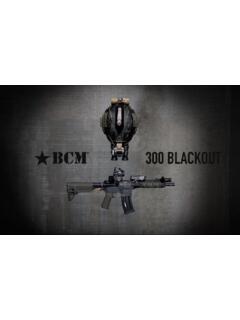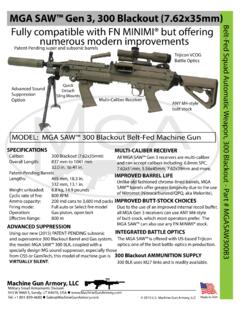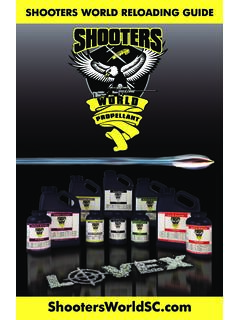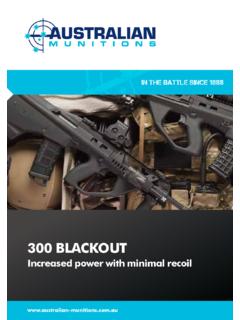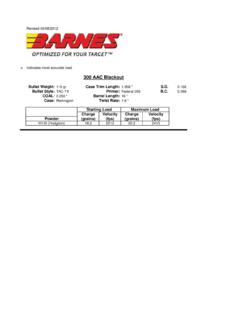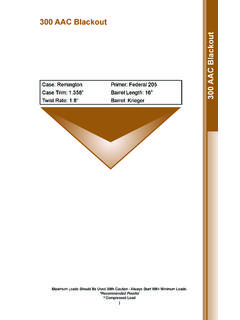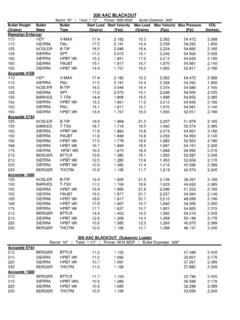Transcription of Brass Fetcher Ballistic Testing - Silencer Talk
1 Brass Fetcher Ballistic Testing 300 AAC blackout , various Handloads 06 October2010 Bullet type Impact velocity (ft/sec) Impact kinetic energy (ft*lb) Surface Area (square inch) Penetration depth (inch) Hornady 110gr V-Max 2220 1204 Speer 125gr TNT 2103 1227 Nosler 125gr Ballistic Tip 2063 1181 Remington 125gr Accutip 2057 1174 Sierra 125gr Pro Hunter JSP 2095 1218 Hornady 130gr SP 2086 1256 Barnes 110gr TSX 2233 1218 Notes : Weapon 300 AAC blackout with 16 barrel length. Loads are at various levels of charge to simulate impacts down range Distance feet, muzzle to impact face Hornady 110gr V-Max Shot 1 Shot 2 Shot 3 Calibration depth (Inches, corrected to 590 ft/sec impact velocity) (Ideal gelatin block penetration depth = ) Impact velocity (Measured at 7ft) (ft/sec) 2239 2183 2239 Deepest Penetration Depth (inch) + exit Shot 1 Block Calibration Velocity (ft/sec) Block Calibration Depth (inch) Block Calibration Temperature (Degrees Fahrenheit) Block Core Temperature (Degrees Fahrenheit) 583 Impact Velocity (ft/sec) Deepest Penetration Depth (inch) Maximum Crack Diameter (inch) Maximum Crack Diameter Location (inch) 2239 Cavitation Depth (inch) Notes.
2 Bullet recovered surface area - square inches Bullet recovered diameter Bullet recovered weight Test site conditions 65 degrees Fahrenheit, 42% relative humidity Time out of refrigeration prior to shot impact 3 minutes Figure 1. Side view of Shot 1 gelatin block Figure 2. Top view of Shot 1 gelatin block Figure 3. Projectile view of Shot 1 recovered fragments Shot 2 Block Calibration Velocity (ft/sec) Block Calibration Depth (inch) Block Calibration Temperature (Degrees Fahrenheit) Block Core Temperature (Degrees Fahrenheit) 580 Impact Velocity (ft/sec) Deepest Penetration Depth (inch) Maximum Crack Diameter (inch) Maximum Crack Diameter Location (inch) 2183 Cavitation Depth (inch) Notes : Bullet recovered surface area - square inches Bullet recovered diameter Bullet recovered weight Test site conditions 64 degrees Fahrenheit, 40% relative humidity Time out of refrigeration prior to shot impact 2 minutes Figure 4.
3 Side view of Shot 2 gelatin block Figure 5. Top view of Shot 2 gelatin block Figure 6. Projectile view of Shot 2 recovered fragments Shot 3 Block Calibration Velocity (ft/sec) Block Calibration Depth (inch) Block Calibration Temperature (Degrees Fahrenheit) Block Core Temperature (Degrees Fahrenheit) 590 Impact Velocity (ft/sec) Deepest Penetration Depth (inch) Maximum Crack Diameter (inch) Maximum Crack Diameter Location (inch) 2239 Exited at Cavitation Depth (inch) Notes : Bullet recovered surface area - square inches Bullet recovered diameter Bullet recovered weight Test site conditions 64 degrees Fahrenheit, 40% relative humidity Time out of refrigeration prior to shot impact 2 minutes Figure 7. Side view of Shot 3 gelatin block Figure 8.
4 Top view of Shot 3 gelatin block Figure 9. Projectile view of Shot 3 recovered fragments 110gr V-Max performance against car windshield This bullet appears to fragment severely after impact with thick laminated car windshield glass turned at a 45 degree obliquity. While this fragmentation causes a shallower bullet penetration depth in a soft target located behind the windshield glass, the penetration depth of these fragments into gelatin indicates that they could pose a risk to unprotected eyes and structures located close to the skin of an attacker. Shot 1 Block Calibration Velocity (ft/sec) Block Calibration Depth (inch) Block Calibration Temperature (Degrees Fahrenheit) Block Core Temperature (Degrees Fahrenheit) 598 Impact Velocity (ft/sec) Deepest Penetration Depth (inch) Maximum Crack Diameter (inch) Maximum Crack Diameter Location (inch) 2282 Cavitation Depth (inch) Notes.
5 Bullet recovered surface area - square inches Bullet recovered diameter Bullet recovered weight Test site conditions 62 degrees Fahrenheit, 44% relative humidity Time out of refrigeration prior to shot impact 3 minutes Side View of V-Max impact with windshield glass (45 degree obliquity, 2282 ft/sec impact velocity) Top View of V-Max impact with windshield glass (45 degree obliquity, 2282 ft/sec impact velocity) Frag View of V-Max impact with windshield glass (45 degree obliquity, 2282 ft/sec impact velocity) Barrier View of V-Max impact with windshield glass (45 degree obliquity, 2282 ft/sec impact velocity) (l-r, impact-exit) Soft-Catch images In order to isolate the effect of the bullets collision with the barrier, the gelatin backing was removed and a soft-catch box was placed behind windshield glass and the test was repeated.
6 It can be said that windshield glass appears to strip away a great portion of the V-max bullet upon impact. 2218 ft/sec impact velocity 2249 ft/sec impact velocity 110gr V-Max performance against car doors This bullet appears to fragment severely after impact with 20 gauge sheet metal turned at 0 degree obliquity. While this fragmentation causes a shallower bullet penetration depth in a soft target located behind the car door, the penetration depth of these fragments into gelatin indicates that they could pose a risk to unprotected eyes and structures located close to the skin of an attacker. In order to exacerbate the effect of this bullet, which is intentionally made with fragile construction to break up on impact with varmint animals, colliding with steel sheet metal, the FBI car door fixture was turned at a 45 degree angle such that the apparent thickness of the steel was increased.
7 Shot 1 (0 degree obliquity) Block Calibration Velocity (ft/sec) Block Calibration Depth (inch) Block Calibration Temperature (Degrees Fahrenheit) Block Core Temperature (Degrees Fahrenheit) 589 Impact Velocity (ft/sec) Deepest Penetration Depth (inch) Maximum Crack Diameter (inch) Maximum Crack Diameter Location (inch) 2234 Cavitation Depth (inch) Notes : Bullet recovered surface area - square inches Bullet recovered diameter Bullet recovered weight Test site conditions 62 degrees Fahrenheit, 44% relative humidity Time out of refrigeration prior to shot impact 3 minutes Side View of V-Max impact with car door (0 degree obliquity, 2234 ft/sec impact velocity) Top View of V-Max impact with car door (0 degree obliquity, 2234 ft/sec impact velocity) Frag View of V-Max impact with car door (0 degree obliquity, 2234 ft/sec impact velocity) Barrier View of V-Max impact with car door (0 degree obliquity, 2234 ft/sec impact velocity) (l-r impact-exit) Soft-Catch images 2276 ft/sec impact velocity 2287 ft/sec impact velocity Shot 2 (45 degree obliquity)
8 Block Calibration Velocity (ft/sec) Block Calibration Depth (inch) Block Calibration Temperature (Degrees Fahrenheit) Block Core Temperature (Degrees Fahrenheit) 581 Impact Velocity (ft/sec) Deepest Penetration Depth (inch) Maximum Crack Diameter (inch) Maximum Crack Diameter Location (inch) 2249 Cavitation Depth (inch) Notes : Bullet recovered surface area - square inches Bullet recovered diameter Bullet recovered weight Test site conditions 62 degrees Fahrenheit, 44% relative humidity Time out of refrigeration prior to shot impact 3 minutes Side View of V-Max impact with car door (45 degree obliquity, 2249 ft/sec impact velocity) Top View of V-Max impact with car door (45 degree obliquity, 2249 ft/sec impact velocity) Frag View of V-Max impact with car door (45 degree obliquity, 2249 ft/sec impact velocity) Barrier View of V-Max impact with car door (45 degree obliquity, 2249 ft/sec impact velocity) (l-r impact-exit) Speer 125gr TNT Shot 1 Shot 2 Shot 3 Calibration depth (Inches, corrected to 590 ft/sec impact velocity)
9 (Ideal gelatin block penetration depth = ) Impact velocity (Measured at 7ft) (ft/sec) 2091 2029 2190 Deepest Penetration Depth (inch) Shot 1 Block Calibration Velocity (ft/sec) Block Calibration Depth (inch) Block Calibration Temperature (Degrees Fahrenheit) Block Core Temperature (Degrees Fahrenheit) 577 Impact Velocity (ft/sec) Deepest Penetration Depth (inch) Maximum Crack Diameter (inch) Maximum Crack Diameter Location (inch) 2091 Cavitation Depth (inch) Notes : Bullet recovered surface area - square inches Bullet recovered diameter Bullet recovered weight Test site conditions 65 degrees Fahrenheit, 44% relative humidity Time out of refrigeration prior to shot impact 3 minutes Figure 10. Side view of Shot 1 gelatin block Figure 11.
10 Top view of Shot 1 gelatin block Figure 12. Projectile view of Shot 1 recovered fragments Shot 2 Block Calibration Velocity (ft/sec) Block Calibration Depth (inch) Block Calibration Temperature (Degrees Fahrenheit) Block Core Temperature (Degrees Fahrenheit) 578 Impact Velocity (ft/sec) Deepest Penetration Depth (inch) Maximum Crack Diameter (inch) Maximum Crack Diameter Location (inch) 2029 Cavitation Depth (inch) Notes : Bullet recovered surface area - square inches Bullet recovered diameter Bullet recovered weight Test site conditions 64 degrees Fahrenheit, 40% relative humidity Time out of refrigeration prior to shot impact 2 minutes Figure 13. Side view of Shot 2 gelatin block Figure 14. Top view of Shot 2 gelatin block Figure 15.


